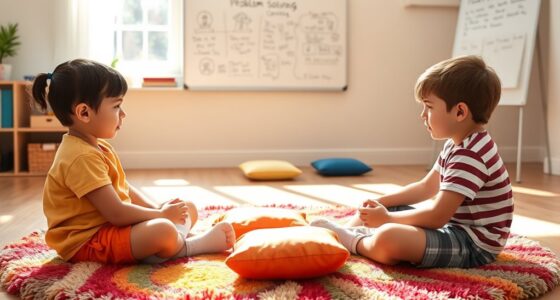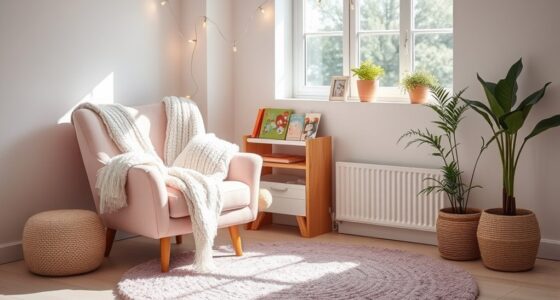To build a daily play rhythm that truly works, set consistent times for play sessions, like morning and late afternoon. Keep your schedule flexible to adapt to changing interests and needs, and use visual cues or timers to signal shifts. Incorporate a variety of activities—arts, outdoor play, role-playing—so your child stays engaged and excited. Focusing on playful discipline, like sharing and taking turns, helps foster positive behavior. Keep exploring for more tips to create a joyful, balanced routine.
Key Takeaways
- Establish consistent play times, such as mornings and late afternoons, to create predictability and stability.
- Incorporate flexible routines that include spontaneous activities to keep play engaging and adaptable.
- Use visual cues or timers to signal transitions, helping children understand and manage their play schedule.
- Mix diverse activities—arts, outdoor play, role-playing—to maintain interest and stimulate development.
- Reinforce positive behavior during play with gentle guidance, encouraging sharing, patience, and cleanup as part of the routine.

Ever wonder how to make playtime a consistent and joyful part of your daily routine? Creating a reliable play rhythm isn’t just about fitting in activities; it’s about fostering a sense of security and excitement for your child. To do this effectively, you need to develop a plan that balances structured moments with spontaneous fun, and that’s where playful discipline and creative scheduling come into play. Playful discipline isn’t about punishment—it’s about guiding your child through play that teaches patience, sharing, and problem-solving. When combined with creative scheduling, you can craft a daily routine that feels natural and engaging for both of you.
Start by establishing a predictable pattern that your child can anticipate. Kids thrive on routine, but it’s important to keep it flexible enough to adapt to your family’s needs. For example, set aside specific times for play that occur each day—perhaps a morning session after breakfast and another in the late afternoon. Use these scheduled moments as anchors, giving your child something to look forward to and helping them understand that play isn’t just spontaneous but an integral part of your day. Incorporate playful discipline by gently guiding your child during play, encouraging them to take turns, share toys, or clean up afterward. This approach teaches valuable life skills without disrupting the joyful flow of play.
Be creative in your scheduling to keep things fresh and engaging. Mix up the types of play—arts and crafts, outdoor adventures, imaginative role-playing—to cater to your child’s evolving interests. If you notice a particular activity sparks enthusiasm, weave it into your daily routine more often. Use timers or visual cues to signal transitions, so your child learns to switch from one activity to another smoothly. This not only reinforces the routine but also helps your child develop a sense of time and self-regulation. Incorporating structured routines based on proven methods like consistent scheduling can further enhance your child’s sense of security and predictability.
Frequently Asked Questions
How Do I Adjust My Play Rhythm During Busy Seasons?
During busy seasons, you should prioritize flexibility planning to adapt your play rhythm. Use time management techniques to identify windows for play, even if shorter. Adjust your schedule by shifting or reducing play sessions, and stay open to changing your routine as needed. This approach helps you maintain balance and enjoyment, ensuring your play rhythm remains sustainable despite increased demands on your time.
What Tools Can Help Track My Daily Play Schedule?
You can use music journals and practice apps to track your daily play schedule effectively. Music journals let you jot down what you practiced, goals, and reflections, helping you stay organized. Practice apps offer timers, progress tracking, and reminders to keep you on track. Together, these tools help you monitor consistency, identify patterns, and make adjustments, ensuring your daily play rhythm stays productive even during busy seasons.
How Long Should Each Play Session Ideally Last?
Your play session duration should ideally last between 20 to 30 minutes, balancing engagement and focus. Ideal timing varies based on your energy levels, so schedule play when you’re most alert and relaxed. Avoid overly long sessions that cause fatigue, and consider breaking up longer periods with short breaks. This approach helps maintain enthusiasm and ensures you get the most out of your playtime without burnout.
How Do I Stay Motivated to Stick With My Rhythm?
You can’t let motivation boosters slip away; they’re your secret weapon! To stay motivated, remind yourself why you started and celebrate small wins daily. Keep routine consistency by scheduling play sessions at the same time each day—like clockwork. Surround yourself with inspiring cues and avoid burnout by mixing things up. When you stay committed and energized, your rhythm becomes unstoppable, turning playtime into a habit you love and look forward to!
What Are Common Mistakes to Avoid When Building a Play Routine?
Avoid common mistakes like neglecting playtime consistency, which can disrupt your routine’s flow. Don’t stick to the same activity every day; instead, incorporate activity variety to keep your child engaged and prevent boredom. Also, be cautious about over-scheduling, which can lead to burnout. Focus on a balanced routine that offers consistent play opportunities and diverse activities, ensuring your child’s development stays fun and sustainable.
Conclusion
By establishing a daily play rhythm, you create a sustainable balance that boosts your creativity and well-being. Consistency is key—just like how studies show that children who engage in regular play develop better problem-solving skills. So, commit to small, daily play moments, and you’ll notice increased joy and productivity. Remember, a steady rhythm not only fuels your mind but also makes play an enjoyable part of your everyday life.










